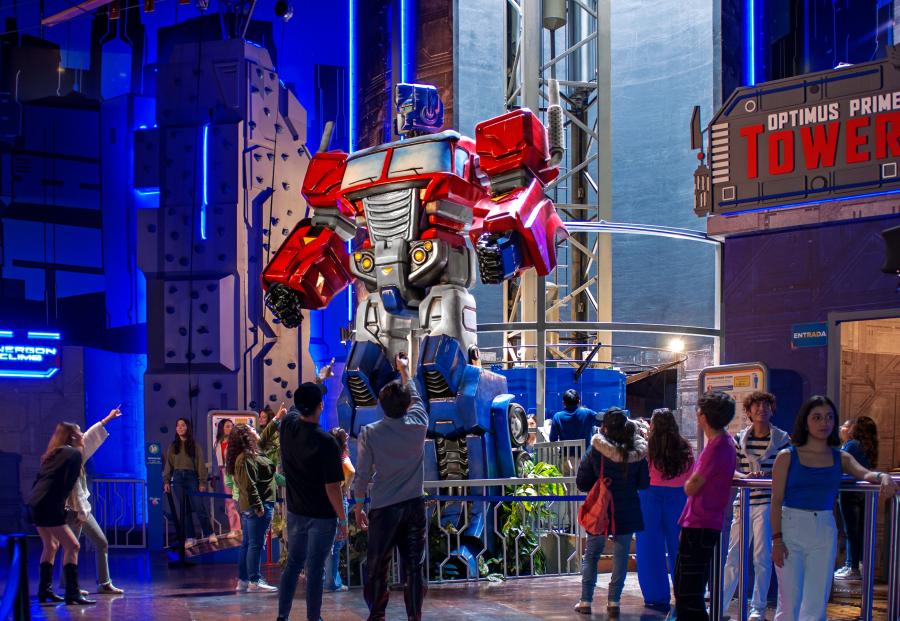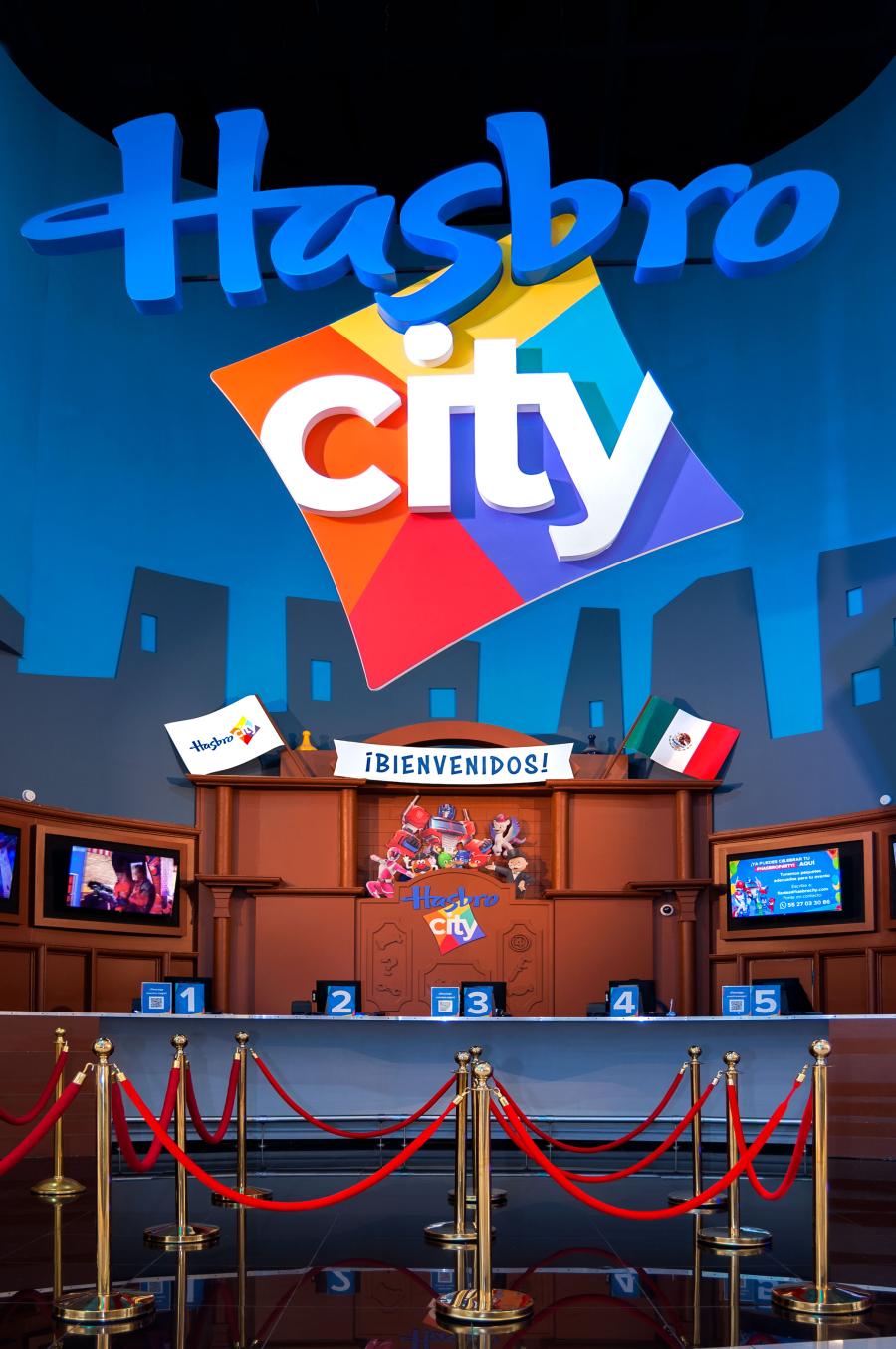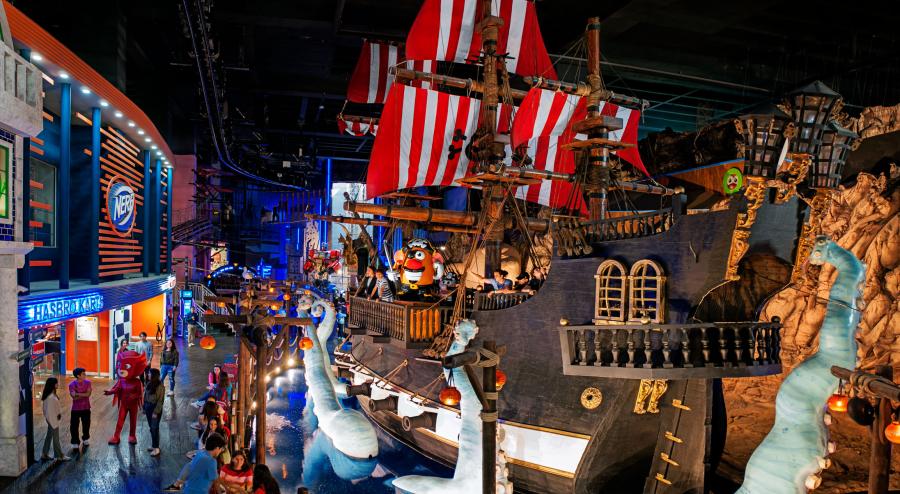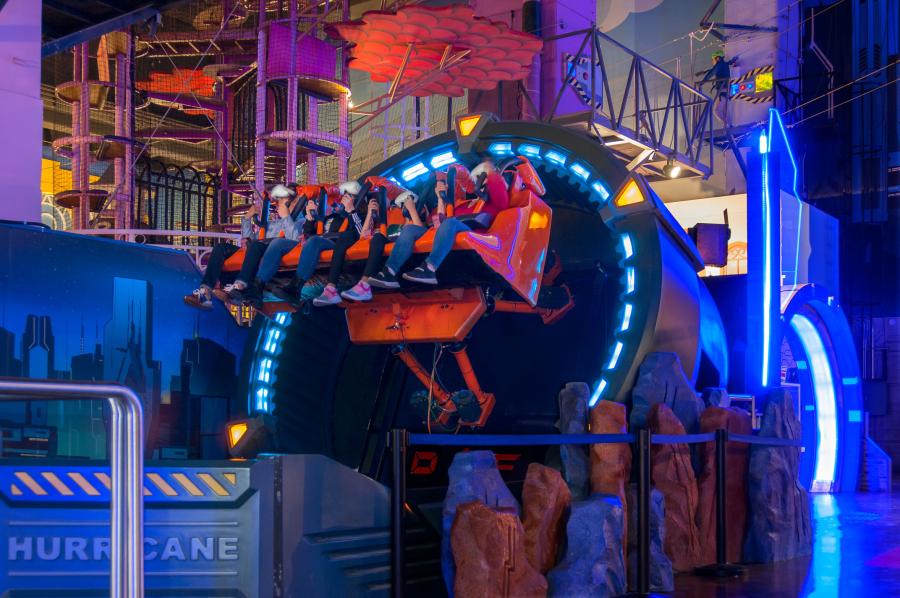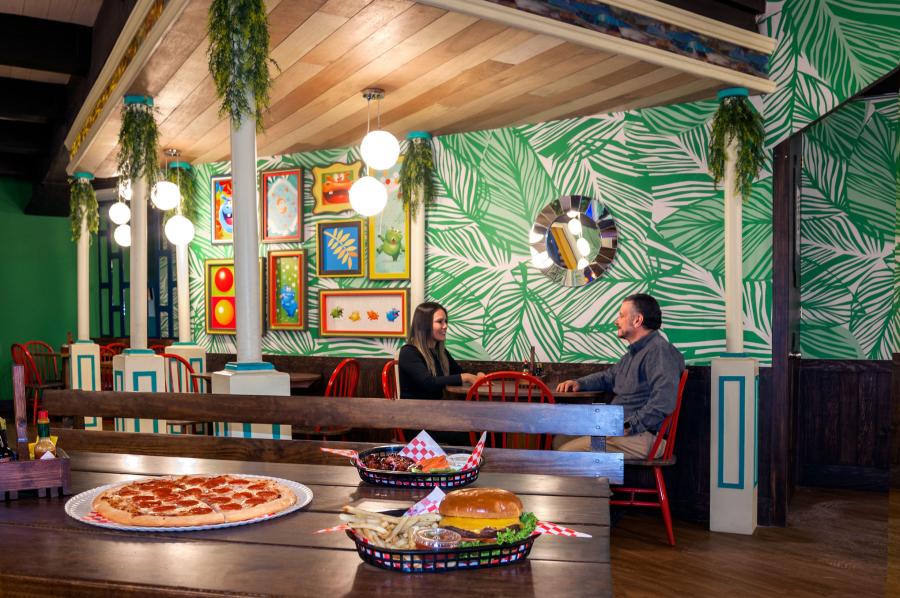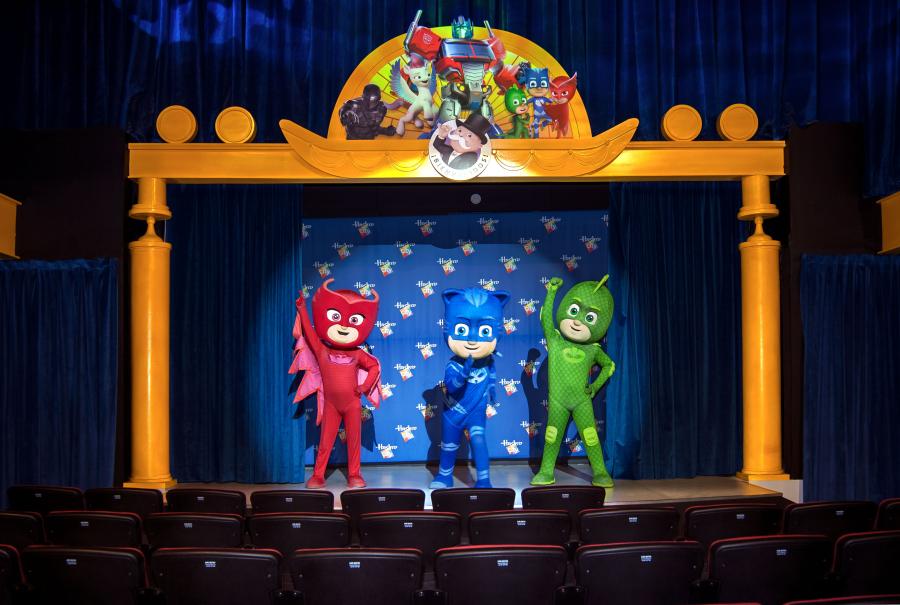Whether classified as a family entertainment center (FEC) or an indoor amusement park, it’s all about family fun (and games) inside the Paseo Interlomas shopping mall—a 10,000-square-meter facility that’s a new jewel in the crown of Mexico’s leisure attractions.
With one of the world’s most storied toy brands as the banner, inspiration, and theme of the new Hasbro City located in Mexico City, a new standard exists when fusing activities, now labeled as “shoppertainment.” The park opened its gates to guests on June 23, 2023, immediately diversifying the mall it calls home.
“In Latin America, malls play a very important role for society,” says Fernando López, CEO of Grupo VXT and member of the board of REIL, the attraction’s Mexico-based developer. “Malls and shopping centers are where most family [units] are used to spending one of their weekend days.”
In addition to the shopping and dining available, malls offer an opportunity for families to spend an entire day secure and shielded from bad weather. Malls in Latin America understand the desires of families and are increasingly looking for entertainment offerings.
Luis Javier Santoyo, CEO of Hasbro City, stresses the importance of the FEC appealing to a wide range of guests. “What we tried to do is make a family park—not just for kids, not just for teenagers,” says Santoyo, adding park planners made a conscious effort to balance the park with activities for entire families starting with children three years old, up to teenagers between 15 or 16 years old.
Entering the Hasbro Way
In a row of storefronts on the mall’s main corridor, an imposing edifice—a grand entrance gate two stories tall—dominates the galleria, inviting guests in. In lieu of traditional ticket booths, a concierge-style service counter, complete with wood paneling, immediately sets the tone for the elevated experience ahead.
Once past the security checkpoint, guests encounter a two-story mezzanine surrounding an animatronic figure of Hasbro City’s mayor, Mr. Monopoly. Mr. Monopoly is king here, high-lighting Hasbro Inc.’s golden game that celebrated its 100th anniversary in 2023.
Immediately after meeting Uncle Pennybags and passing through The Garden Walk—a courtyard of topiaries shaped like various characters found in the Hasbro toys and games franchise—guests turn the corner onto Main Street, where designers placed two-story-tall buildings with storefronts that offer access to park attractions, food and beverage (F&B) locations, and an arcade. Beyond, guests wander the meandering streets and alleyways to additional themed attractions.
Hasbro City prides itself on having an F&B experience with high-quality offerings served in themed environments that ensure guests don’t feel the need to stray into the mall’s nearby food court. From full meals to snacks, desserts, and sweets, there is something for a broad range of palates. Vegans and vegetarians will feel at home too, while parents are welcome to enjoy adult beverages.
What’s in an IP?
While the Hasbro brand and its associated intellectual properties (IPs) offer a robust bouquet of content for an FEC or amusement park, Hasbro City’s designers proceeded with caution when incorporating the IP.
“It’s a challenge for us, as you’re seeing Hasbro City, we have a lot of brands, a lot of characters, but it’s not the responsibility of our fans to understand that [the] characters or brands are the Hasbro’s family, and that kind of connection between biggest brands like Hasbro,” states Emiliano Limón, partner and vice president of marketing and creativity at Grupo VXT and Hasbro City.
While park guests may not immediately recognize the name Hasbro as a board game or toy company, its various IPs offer great appeal and tremendous brand recognition for the FEC.
Hasbro regularly debuts new content and looks for ways to keep its IP relevant. The company has released new movies, such as “Dungeons and Dragons,” while a new “Transformers” series is set to launch on Netflix, further cementing the brands in pop culture.
“We have the licensee of more than 33 different properties from Hasbro,” says Dieter Cornejo, partner and vice president of special projects at Grupo VXT and Hasbro City, of the extensive portfolio of IPs found inside the themed zones of Plaza Central, The Garden Walk, Main St., El Muelle, Equestria, and Cybertron.
Learning a New Skillset
REIL, the private equity capital company investing in Hasbro City, was an investor in the previous occupant of the same space, Imagic Park. Initially, the existing park was to be upgraded, Cornejo tells Funworld. Reimagining the former attraction led to Cornejo (who specializes in finance) developing of a new skill set.
“We didn’t have any experience, but we now have a master’s degree, let’s say in three years of entertainment in order to achieve this,” Cornejo says.
When idealizing how to transform the park, one company won the bid for the redesign, that included an extensive make¬over. Cornejo explained his team was not entirely familiar with the Hasbro brands at the start and this presented a challenge, since the team needed to some existing marquee attractions.
An example front of mind for Cornejo is the drop tower that stands through an opening in the roof and elevates riders above a nearby highway. The ride was renamed the Optimus Prime Tower, as the team notes, it made sense to retheme the ride to something robotic and incorporate it into a more thrilling area—Cybertron.
Another source of pride for the for the team, also within Cybertron, was the conversion of a virtual reality (VR) hurricane ride that was also retained from the previous park. The team again found itself responsible for making creative decisions while working with Hasbro. The result, at Hasbro’s request, is a new movie that effectively converts the former attraction into the new Transformers Energy Surge, provided by DOF Robotics, which aided in the creation of the ride’s new video and programming.
A new Magic Bike circular ride from IAAPA-member Zamperla was placed inside Equestria—a My Little Pony-themed zone. Cornejo and his team presented a concept to convert the ride’s vehicles into flying ponies. Yet, Hasbro, Inc. required a different way to integrate My Little Pony.
“We [discovered that you] cannot put a face of My Little Pony on the vehicles, so we put a pony statue on top of the attraction.” The new ride experience includes a thematic backdrop and sound effects.
When Hasbro, Inc. was eager to develop live entertainment for the park, Lemon Drops was sought as another partner. Hasbro City’s Emiliano Limón, also CEO of Lemon Drops, wrote the script for two shows (a third show is presented during the holidays) performed in the Teatro Coca-Cola—a multipurpose room with theater seating and a stage that has the flexibility of offering meet¬ing space as a part of the park’s group sales program. Limón and his team also sourced the sound effects and led all phases of the production process. He says Hasbro, Inc. was more than happy with the final product. He says Hasbro, Inc. was more than happy with the final prod¬uct, while guest feedback is overwhelmingly positive.
Forging Partnerships
Luis Narchi, CEO of Narmex and member of the boards of REIL and Hasbro City, explains the process of building partnerships.
“There are many sponsors that want to be in this FEC now. We started many years ago with PowerPoint presentations to try to have sponsorships and now we have a beautiful showroom for the sponsorship to come invest with us,” Narchi tells Funworld.
The park offers an opportunity for 360-degree promotions inside and outside the park with the Hasbro brand. Narchi highlights the current challenges with sponsorships include changing consumer demands over time and the new goal to maximize the brand’s earning potential through merchandise, bringing the “shoppertainment” designation into focus.
“They want to sell more product,” he says. Amusement parks offer opportunity to be creative with sponsorship offer¬ings, while the challenge with Hasbro City, for example, is coordinating a three-pronged partnership between the park, Hasbro, Inc., and the various companies sponsoring the attrac¬tions. Examples include Coca-Cola, Santander Bank, and Mobility Ado, that are integrated with the park’s offerings.
Examples include Coca-Cola, Santander Bank, and Mobility Ado, a telecommunications company that are integrated with the park’s offerings.
A Strategic Location and Guide Map for Expansion
Santoyo recommends facility owners and operators need to do their research when looking to expand, renovate, rebrand, or move. That starts with looking at existing real estate.
“Actually, the location chose us,” he says, adding the previous park that operated at the site for one and a half years proved the location worked, but needed a strong brand to inject new life. Choosing a location is a complex undertaking, Lopez says. “It’s about to doing very, very deep market research,” he says.
With their careful balancing of attractions and offerings at Hasbro City, the operator is confident they have a formula for success that can be reproduced elsewhere.
“That’s for sure. Actually, that’s sort of plan, to replicate this park in different parts, and different boroughs in different states of Mexico. And we want to go to Latin America to develop these kinds of parts or multi-brand like this one or unit brands,” Santoyo reveals to Funworld.
Lopez also shares an aggressive expansion is in the plans for the company.
“The idea is to develop at least 12 FECs like this one with different sizes, some other kind of business models.” Finally, the Hasbro license extends across Mexico and the rest of Latin America, with the exception of Brazil.
The goal is to use the formula to open similar FECs, while the challenge is to develop them with distinguishable differences. “We want to change the models, and then you can change the experience.”
Santoyo continues that the team believes other attractions will be different enough that guests who visit the Mexico City location and later visit another Hasbro attraction, will get a distinguishably different experience.
“But the challenge is to make it with this quality, but in different way,” explains Santoyo.
A Balance of Offerings
Cornejo is happy with the results and shares a strategy other attraction operators can benefit from. “Always our goal was having something for the whole family. When the kids come here with parents, they can ride each one of the attractions with or without kids. The final result is we have each one of these attractions merge in a way that we have a family concept,” he says.
Secluded in a section of its own await attractions and experiences for the park’s youngest guests. Children can play in sandboxes with Tonka trucks, among miniature cityscapes sized only for the small fry, and an obstacle course for all ages. Limited exits in this area permits parents to safely supervise their children at play without fear of them wandering too far.
On the opposite end of the spectrum of offerings is Monopoly the Ride—an inverted roller coaster from Wiegand that is suspended from the ceiling, two stories up, taking riders through an opening in the building above the freeway below, where motorists can witness the emotion on the faces of riders. Much of the Cybertron zone is outlined in a ropes course that utilizes the airspace above pedestrians, and puts climbers close to the Optimus Prime Tower. The kinetic energy found in the park’s layout and integration of attractions is an integral part of the experience.
Lopez believes Hasbro City is different than any other attraction. “There’s nothing like this one. In a way it’s unique. It’s a combination of theme park and an FEC. We have attractions that are typically for amusement parks and some others that there are [typical of an] FEC.” The important thing with Hasbro City is the brand.
And Hasbro brands are for families, Lopez concludes. “All of members of the family can play.”

